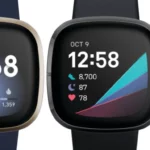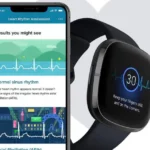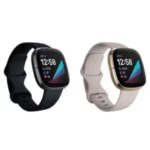


User Manual Version 1.4
Getting Started
Welcome to Fitbit Alta HR, the heart rate wristband that motivates you to reach
your goals in style. Take a moment to review our complete safety information at
https://www.fitbit.com/safety.
What’s in the box
Your Fitbit Alta HR box includes:
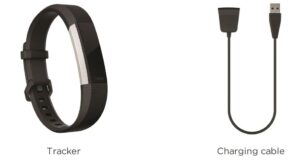
The top and bottom detachable wristbands can be swapped for other colors and
materials sold separately.
What’s in this manual
We’ll explain how to create a Fitbit® account and make sure your tracker can
transfer the data it collects to your dashboard. The dashboard is where you’ll set
goals, analyze historical data, identify trends, log food and water, keep up with
friends, and much more. As soon as you’re done setting up Alta HR, you’re ready to
start moving.
Next, we’ll explain how to find and use the features that interest you and how to
adjust your preferences. For more information, tips, and troubleshooting, browse
our comprehensive help content at help.fitbit.com
Set up Fitbit Alta HR
For the best experience, use the Fitbit app for iOS, Android, or Windows 10. If you
don’t have a smartphone or tablet, you can also use a computer and fitbit.com
instead, but keep in mind that a phone is required for call, text, and calendar
notifications.
Your Fitbit account asks for information such as height, weight, and sex in order to
calculate your stride length and to estimate distance, basal metabolic rate, and
calorie burn. When you set up your account, your name and photos are visible to all
other Fitbit users. You have the option to share other information, but most of the
information you provide is private by default.
Charge Alta HR
To charge your tracker:
- Plug the charging cable into the USB port on your computer or a UL-certified
USB wall charger. - Clip the other end of the charging cable to the port on the back of the tracker.
The pins on the charging cable must lock securely with the port. You’ll know
the connection is secure when the tracker vibrates and you see a battery icon
on your tracker’s display. The battery icon disappears after three seconds

Charging fully takes about one to two hours. While the tracker charges, you can tap
it to check the battery level. A fully charged tracker shows a solid battery icon.
Set up with your phone or tablet
The free Fitbit app is compatible with more than 200 devices that support iOS,
Android, and Windows 10 operating systems.
To get started:
- Find the Fitbit app in one of the locations below, depending on your device. If
you’re unsure if the Fitbit app is compatible with your phone or tablet, see
fitbit.com/devices -Apple App Store for iOS devices such as an iPhone or iPad. -Google Play Store for Android devices such as the Samsung Galaxy S8 and Google Pixel. -Microsoft Store for Windows 10 devices such as the Lumia phone or Surface tablet. - Install the app. If you don’t have an account with the store, you must create
one before you can download the app. - When the app is installed, open it and tap Join Fitbit to be guided through a
series of questions that help you create your Fitbit account, or log in to your
existing account. - Continue following the on-screen instructions to connect, or “pair,” Alta HR to your phone or tablet. Pairing makes sure the tracker and phone or tablet can
communicate with one another (sync data back and forth).
When you’re done pairing, read through the guide to learn more about your new
tracker and then explore the Fitbit dashboard.
Set up with your Windows 10 PC
If you don’t have a smartphone, you can set up and sync Alta HR using a Bluetoothenabled Windows 10 PC and the Fitbit app.
To get the Fitbit app for your computer:
- Click the Start button on your PC and open the Microsoft Store.
- Search for “Fitbit app”. After you find it, click Free to download the app to
your computer. - If you’ve never downloaded an app to your computer, you’ll be prompted to
create an account with the Microsoft Store. - Click Microsoft account to sign in with your existing Microsoft account. If you
don’t already have an account with Microsoft, follow the on-screen instructions to create a new account. - When the app is installed, open it and click Join Fitbit to be guided through a
series of questions that help you create your Fitbit account, or log in to your
existing account. - Continue following the on-screen instructions to connect, or “pair,” Alta HR to your computer. Pairing makes sure the tracker and computer can communicate with one another (sync data back and forth).
When you’re done pairing, read through the guide to learn more about your new
tracker and then explore the Fitbit dashboard.
Set up with your Mac
If you don’t have a compatible phone or tablet, you can set up your tracker with a
Bluetooth-enabled Mac and use the fitbit.com dashboard to see your stats. To use
this method you’ll first install a free software application called Fitbit Connect that
lets Alta HR sync its data with your fitbit.com dashboard.
To install Fitbit Connect and set up your tracker:
- Go to fitbit.com/setup
- Scroll down and click the option to download for Mac.
- If prompted, save the file that appears.
- Find and double-click the file to open the installer program (Install Fitbit
Connect.pkg). - Click Continue to move through the installer
- When prompted, choose Set up a New Fitbit Device.
- Follow the on-screen instructions to create a Fitbit account, or log in to your
existing account.
When you’re done with the setup, Fitbit guides you through an introduction to Alta
HR and takes you to the fitbit.com dashboard.
Sync data to your Fitbit account
Regularly sync Alta HR to transfer data to your dashboard. The dashboard is where
you’ll track your progress, see exercise history, track your sleep patterns, log food
and water, identify trends, participate in challenges, and much more. We recommend syncing at least once a day.
The Fitbit app and Fitbit Connect use Bluetooth Low Energy technology to sync
data with Alta HR.
Each time you open the Fitbit app, Alta HR syncs automatically when it’s nearby.
Alta HR also syncs with the app periodically if All-Day Sync is on. To turn on this
feature:
From the Fitbit app dashboard, tap or click the Account icon ( ) > Alta HR tile
> All-Day Sync.
You can also use the Sync Now option in the app at any time.
Fitbit Connect on your Mac syncs every 15 minutes if the tracker is within 30 feet of the computer. To force a sync, click the Fitbit Connect icon located near the date
and time on your computer and choose Sync Now.
Wear Alta HR
Place Alta HR around your wrist. If you need to attach a different size wristband, or if you purchased an accessory wristband, you’ll find instructions in “Change the
wristband” on the next page.
Placement for all-day wear vs exercise
When you’re not exercising, wear Alta HR a finger’s width below your wrist bone.
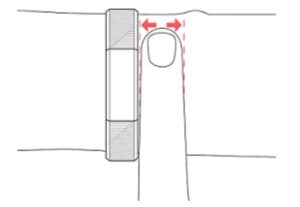
For optimized heart-rate tracking while exercising, keep these tips in mind:
- Try wearing Alta HR higher on your wrist during exercise for an improved fit
and more accurate heart-rate reading. Many exercises, such as bike riding or
weight lifting, cause you to bend your wrist frequently, which can interfere
with the heart-rate signal if the tracker is lower on your wrist.
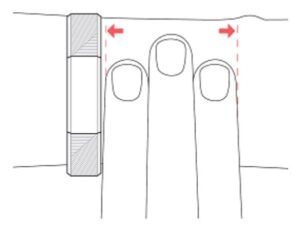
- Make sure the tracker is in contact with your skin.
- Don’t wear your tracker too tight; a tight band restricts blood flow, potentially
affecting the heart-rate signal. However, the tracker should be slightly tighter
(snug but not constricting) during exercise than during all-day wear. - With high-intensity interval training or other activities where your wrist is
moving vigorously and non-rhythmically, the movement may limit the sensor’s ability to provide a heart-rate reading. If your tracker doesn’t show a heart-rate reading, try relaxing your wrist and staying still briefly (about 10 seconds). You should see a heart-rate reading.
Wrist choice and dominant hand
For greater accuracy and ease of use, Alta HR needs to know which wrist you wear
it on (right or left) and which hand you consider dominant (right or left). Your
dominant hand is the one you usually write or throw with.
During setup, you’re asked to choose the wrist where you’re going to wear Alta HR.
Should you later decide to move Alta HR to the other wrist, change the Wrist
setting. You can also change your dominant hand at any time with the Handedness
setting. Both settings are found in the Account section of the Fitbit app.
Change the wristband
The wristband has two separate bands (top and bottom) that you can swap with
accessory bands sold separately.
Remove a wristband
To remove the wristband:
- Turn Alta HR over and find the band latches—there’s one on each end where the band meets the frame.
- To release the latch, press down on the flat metal button on the strap.
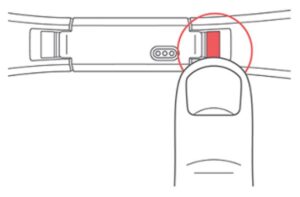
- Slide the band up to release it from the tracker.
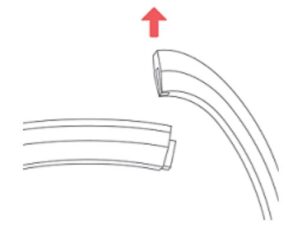
- Repeat on the other side.
If you’re having trouble removing the band or if it feels stuck, gently move the band
back and forth to release it.
Attach a new wristband
Before you attach a new wristband, first identify the top and bottom bands. The top band has a buckle on it and should be attached on the side closest to the charging port. The bottom band has notches in it.
To attach a band, slide it down on the end of the tracker until you feel it snap into
place.

Basics
Learn how best to navigate, check the battery level, and care for your tracker.
Navigate Alta HR
Alta HR has an OLED tap display that can be oriented horizontally or vertically. You can choose from several clock faces, each with a unique design. Single-tap the
display to flip through your stats.
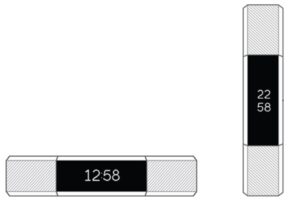
When you’re not using Alta HR the display is dimmed. To wake it up:
- Double-tap your tracker.
- Turn your wrist towards you. This behavior, known as Quick View, can be
turned off in your tracker settings.
For best results, tap your tracker where the screen meets the band as shown.
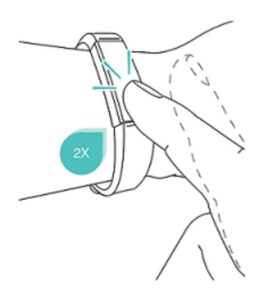
Check battery level
Your fully charged Alta HR has a battery life of up to 7 days. Note that battery life
and charge cycles vary with use, settings, and many other factors. Actual results will
vary.
If your battery is low, when you wake up your Alta HR you’ll see low battery icon
after a few seconds. If you see a critical battery icon you’ll be unable to flip through
your stats until you charge your tracker. Your tracker continues to track your activity until your battery runs out. Note that heart rate tracking will stop when your battery level is at approximately 5%.

You can check your battery level at any time on the battery screen on your tracker
or on your Fitbit dashboard. You must turn on the battery screen in the Fitbit app, it is not on your tracker by default.
Care for Alta HR
It’s important to clean and dry your Alta HR regularly. For instructions and more
information, see fitbit.com/productcare
Activity and Sleep
Alta HR continuously tracks a variety of stats whenever you wear it. The information is transferred to your dashboard every time you sync your tracker.
View all-day stats
Tap your Alta HR to see these all-day stats:
- Steps taken
- Current heart rate
- Resting heart rate (optional)
- Distance covered
- Calories burned
- Active minutes
Other stats captured by your tracker are available on your Fitbit dashboard, including:
- Your sleep history, including hours slept and sleep patterns
- The hours of the day that you were stationary vs. active (walked at least 250
steps) - Your exercise history and progress towards a weekly exercise goal
- Your beats per minute (BPM), average resting heart rate, and time spent in
heart-rate zones.
Note: Alta HR stats reset at midnight to begin a new day.
Double-tap your Alta HR to wake it up. When you see the clock, tap to see each of
your stats in turn. If you have an alarm set, you’ll also see the next alarm time.

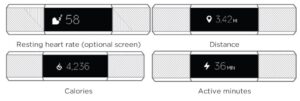
Check your heart rate
Alta HR allows you to view your real-time heart rate and your resting heart rate on
your tracker. To view your heart rate, tap your tracker until you get to the heart rate
screen where you’ll see your current heart rate. Tap again until you get to the
resting heart rate screen to see your resting heart rate. You must turn on the resting
heart rate screen in the Fitbit app.
Using heart-rate zones
Heart-rate zones help you target the training intensity of your choice. Your tracker
shows your current zone beside your heart rate, and on your Fitbit dashboard you
can see your time spent in zones during a particular day or exercise. Three zones
based on American Heart Association recommendations are available by default, or
you can create a custom zone if you have a specific heart rate you’re targeting.
Default heart-rate zones
Default heart-rate zones are calculated using your estimated maximum heart rate.
Fitbit calculates your maximum heart rate with the common formula of 220 minus
your age.

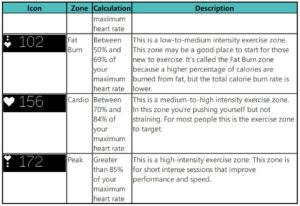
Custom heart rate zones
Instead of using the default heart-rate zones, you can configure a custom zone or a
custom max heart rate if you have a specific target in mind. For example, elite
athletes might have a target that differs from the American Heart Association’s
recommendations for the average person. When you’re in your custom zone you’ll
see a solid heart on your tracker. When you’re not in the zone you’ll see an outline
of a heart.
For more details about heart rate tracking, including links to relevant American
Heart Rate Association information, see help.fitbit.com
Track a daily activity goal
Alta HR tracks your progress towards a daily activity goal of your choice. When you
reach your goal, the tracker vibrates and shows a celebration.
Choose a goal
By default your goal is 10,000 steps per day. You can change the goal to distance
traveled, calories burned, or active minutes and select the corresponding value you
prefer. For example, you may want to keep steps as your goal but change the
target from 10,000 to 20,000 steps.
See goal progress
A goal progress bar helps keep you motivated. The dots in the bar shown below
indicate that you’re more than halfway to your goal.

Track your exercise
The SmartTrack feature automatically detects selected exercises and records the
details in your exercise history.
By default, SmartTrack detects continuous movement at least 15 minutes in length.
You can increase or decrease the minimum duration or disable SmartTrack for one
or more exercise types.
For more information about customizing and using SmartTrack, see help.fitbit.com
Track your hourly activity
Alta HR helps you stay active throughout the day by keeping track of when you’re
stationary and reminding you to move.
If you haven’t walked at least 250 steps in a given hour, at 10 minutes before the
hour you’ll feel a vibration reminding you to walk. When you meet the 250-step
goal after receiving the reminder, you’ll feel a second vibration and see a
congratulatory message.

For more information on hourly activity, including how to customize the hours you
receive reminders, see help.fitbit.com
Track your sleep
Wear Alta HR to bed to automatically track your time asleep and sleep stages. To
see your sleep stats, sync your tracker when you wake up and check your
dashboard.
For more information about sleep tracking, see help.fitbit.com
Set a sleep goal
By default, you have a sleep goal of 8 hours of sleep per night. Customize this goal
to meet your needs.
For more information about your sleep goal, including how to change it, see
help.fitbit.com
Set a bedtime reminder
The Fitbit dashboard can recommend consistent bedtimes and wake times to help
you improve the consistency of your sleep cycle. You can choose to be reminded
nightly when it’s time to start getting ready for bed.
For more information about how to set bedtime reminders, see help.fitbit.com
Learn about your sleep habits
Alta HR tracks several sleep metrics including when you go to bed, how long you’re
asleep, and your time spent in each sleep stage. When you use Alta HR with the
Fitbit dashboard, your tracker can help you understand how your sleep patterns
compare to others of the same sex and age range.
For more information about sleep stages, see help.fitbit.com
Set a silent alarm
Alta HR can gently vibrate to wake or alert you with a silent alarm. You can set up to eight alarms to recur every day or on particular days of the week only. When the
alarm goes off, simply double tap to dismiss.
For more information about customizing and using silent alarms, see help.fitbit.com

Notifications
Over 200 different iOS, Android, and Windows phones can send call, text, and
calendar notifications to your tracker. Keep in mind the phone and tracker must be
within 30 feet of each other to receive notifications. To check whether your phone
is compatible with this feature, go to https://www.fitbit.com/devices
Set up notifications
Check that Bluetooth on your phone is on and that your phone can receive
notifications (often under Settings > Notifications). Then follow the steps below to
set up notifications:
- With your tracker nearby, from the Fitbit app dashboard, tap the Account icon
( ) > Alta HR tile. - Tap Notifications. When you’re prompted to pair Alta HR, follow the onscreen instructions. After you’ve paired your tracker, “Alta HR” will appear in the list of Bluetooth devices connected to your phone. Call, text, and calendar notifications are turned on automatically.
- Tap Notifications > Alta HR in the top left corner to return to device settings.
Your tracker syncs to complete the setup.
For detailed instructions on how to set up notifications, see help.fitbit.com
Receive calendar notifications
Your tracker will show calendar events and any information sent from your calendar app to your phone. Note that if your calendar app does not send notifications to your phone, you won’t receive notifications on your tracker.

If you have an iOS or Windows 10 phone, your Alta HR shows notifications from all calendars synced to the default Calendar app. If you have a third-party calendar
app that is not synced to your default app, you won’t see notifications from that
app.
If you have an Android device, your Alta HR shows calendar notifications from the
calendar app you choose during setup. You can choose from the default Calendar
app on your phone or several third-party calendar apps.
See incoming notifications
If your tracker and phone are within 30 feet of each other, a call, text message, or
calendar event causes the tracker to vibrate and the notification to appear on the
tracker’s display. If the display is off, turn your wrist towards you or double-tap to
wake it up. The notification is only visible for one minute. If you have more than one unread notification, you’ll see a plus sign (+) indicator.
For phone calls, the notification scrolls three times with the name or number of the
caller.
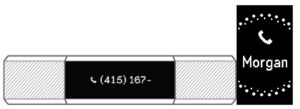
For text messages and calendar events, the notification scrolls once.

For calendar events, the event time scrolls, followed by the name of the event.

The character limit for notifications is 40. Note that all notifications are shown
horizontally, even if your clock orientation is normally vertical.
Customization
This section explains how to adjust the tracker’s display and modify certain
behaviors.
Change the clock face and orientation
Alta HR has several clock faces available in horizontal and vertical styles.
Change the clock face using the Fitbit app. For more information, see
help.fitbit.com
Use Quick View
To preserve battery, your tracker’s screen turns off when not in use. It wakes up
automatically when you turn your wrist towards you (known as Quick View), or you
can wake it up by double tapping your tracker.
For more information about turning Quick View on or off, see help.fitbit.com
Note that Quick View works best when wearing the tracker properly as described in
“Wear Alta HR” on page 11.
Adjust your heart rate setting
Your Alta HR uses PurePulse technology to track heart rate automatically and
continuously. The Heart Rate setting has three options:
- Auto (the default)—Heart rate tracking is active when you’re wearing your
tracker. - Off—Heart rate tracking is off.
- On—Heart rate tracking is on regardless of whether you’re wearing your
tracker.
For more information about adjusting the heart rate tracker, see help.fitbit.com
Updates
We occasionally make free feature enhancements and product improvements
available through firmware updates. We recommend keeping your Alta HR up to
date.
When a firmware update is available you’ll see a notification in the Fitbit app
prompting you to update. When the update starts, a progress bar appears on the
tracker and in the Fitbit app until the update is complete.
Keep your tracker and phone close to each other during the update process.
Note that updating your Alta HR takes several minutes and may be demanding on
the battery. For this reason, we recommend plugging your tracker into the
charging cable before updating.
Troubleshooting
If your tracker is not working properly, review our troubleshooting guidance below.
Visit help.fitbit.com for more information.
Heart-rate signal missing
Alta HR continuously tracks your heart rate while you’re exercising and throughout
the day. Occasionally, the heart-rate sensor on your tracker may have difficulty
finding a good signal. When this happens, you’ll see dashed lines where your
current heart rate usually appears.

If you’re not getting a heart-rate signal, first make sure you’re wearing your tracker
correctly, either by moving it higher or lower on your wrist or by tightening or
loosening the band. Alta HR should be in contact with your skin. After holding your arm still and straight for a short time, you should see your heart rate again.
If the heart rate signal is still missing, check your Heart Rate setting on your Fitbit
dashboard and make sure it’s set to On or Auto.
Unexpected behavior
If you experience one of the following problems, it may be fixed by restarting your
tracker:
- Not syncing despite successful setup
- Not responding to taps despite being charged
- Not tracking your steps or other data
Note: Restarting your tracker reboots the device but does not delete any data.
To restart your tracker:
- Plug the charging cable into the USB port on your computer or a UL-certified
USB wall charger. - Clip the other end of the charging cable to the port on the back of the tracker.
The pins on the charging cable must lock securely with the port. You’ll know
the connection is secure when the tracker vibrates and you see a battery icon
on your tracker’s display. The battery icon disappears after three seconds.
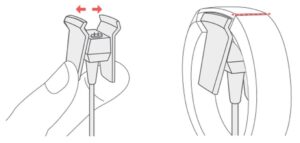
- Press the button on your charging cable 3 times within 8 seconds, briefly
pausing between presses. The button is on the end of the charging cable that
is plugged into the computer.

When you see the Fitbit logo and the tracker vibrates, this means the tracker has restarted.
After your tracker restarts you can unplug it from the charging cable and put it back
on. For additional troubleshooting or to contact Customer Support, see
help.fitbit.com
General Info and Specifications
Sensors
Fitbit Alta HR contains the following sensors and motors:
- A MEMS 3-axis accelerometer, which tracks motion patterns
- An optical heart rate tracker
Materials
The wristband that comes with Alta HR is made of a flexible, durable elastomer
material similar to that used in many sports watches. It does not contain latex.
Accessory wristbands are available in genuine leather.
The clasp and housing on Alta HR are made of surgical-grade stainless steel. While
all stainless steel contains traces of nickel and can cause an allergic reaction in
someone with nickel sensitivity, the amount of nickel in all Fitbit products meets the European Union’s stringent Nickel Directive.
Wireless technology
Alta HR contains a Bluetooth 4.0 radio transceiver.
Haptic feedback
Alta HR contains a vibration motor for alarms, goals, notifications, and reminders.
Battery
Alta HR contains a rechargeable lithium-polymer battery.
Memory
Refer to the following table for information on how long Alta HR stores stats and
data in between the times when it syncs. Stored data consists of steps, distance,
calories burned, active minutes, heart rate, sleep, and stationary vs. active hours.
We recommend syncing Alta HR at least once a day.
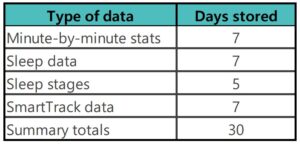
Display
Alta HR has an OLED tap display.
Wristband size
Wristband sizes are shown below. Note that accessory wristbands sold separately
may vary slightly.

Environmental conditions


Learn more
To learn more about your tracker and dashboard, visit help.fitbit.com.
Return policy and warranty
Warranty information and the fitbit.com return policy can be found at
fitbit.com/legal/returns-and-warranty
Regulatory and Safety Notices
Model Name: FB408
USA: Federal Communications Commission (FCC) statement
Notice to the User: The FCC and Industry Canada IDs can also be viewed on your
device. To view content:
- While your tracker is charging, press the button on the charging cable six
times to see the Regulatory screen.
This device complies with Part 15 of the FCC Rules.
Operation is subject to the following two conditions:
- This device may not cause harmful interference and
- This device must accept any interference, including interference that may
cause undesired operation of the device.
FCC Warning
Changes or modifications not expressly approved by the party responsible for
compliance could void the user’s authority to operate the equipment.
Note: This equipment has been tested and found to comply with the limits for a
Class B digital device, pursuant to part 15 of the FCC Rules. These limits are
designed to provide reasonable protection against harmful interference in a
residential installation.
This equipment generates, uses and can radiate radio frequency energy and, if not installed and used in accordance with the instructions, may cause harmful interference to radio communications.
However, there is no guarantee that interference will not occur in a particular installation. If this equipment does cause harmful interference to radio or television reception, which can be determined by turning the equipment off and on, the user is encouraged to try to correct the interference by one or more of the following measures:
- Reorient or relocate the receiving antenna.
- Increase the separation between the equipment and receiver.
- Connect the equipment into an outlet on a circuit different from that to which
the receiver is connected. - Consult the dealer or an experienced radio/TV technician for help.
This device meets the FCC and IC requirements for RF exposure in public or
uncontrolled environments.
FCC ID: XRAFB408
Canada: Industry Canada (IC) statement
This device meets the IC requirements for RF exposure in public or uncontrolled
environments
IC Notice to Users English/French in accordance with current issue of RSS GEN:
This device complies with Industry Canada license exempt RSS standard(s).
Operation is subject to the following two conditions:
- This device may not cause interference, and
- This device must accept any interference, including interference that may
cause undesired operation of the device.
European Union (EU)
Simplified EU Declaration of Conformity
Hereby, Fitbit, Inc. declares that the radio equipment type Model FB408 is in
compliance with Directive 2014/53/EU. The full text of the EU declaration of
conformity is available at the following internet address: www.fitbit.com/safety
Australia and New Zealand
Notice to the User: Regulatory content for this region can also be viewed on your
device. To view content:
- While your tracker is charging, press the button on the charging cable six
times to see the Regulatory screen.
Without permission, any company, firm or user shall not alter the frequency,
increase the power, or change the characteristics and functions of the original
design of the certified lower power frequency electric machinery.
The application of low power frequency electric machineries shall not affect the
navigation safety nor interfere a legal communication, if an interference is found,
the service will be suspended until improvement is made and the interference no
longer exists.
The foregoing legal communication refers to the wireless telecommunication operated according to the telecommunications laws and regulations. The low power frequency electric machinery should be able to tolerate the interference of the electric wave radiation electric machineries and equipment for legal communications or industrial and scientific applications.
United Arab Emirates
TRA Registered No.: ER51305/17
Dealer No.: DA35294/14
Safety Statement
This equipment has been tested to comply with safety certification in accordance
with the specifications of EN Standard: EN60950-1:2006 + A11:2009 + A1:2010 + A12: 2011 + A2:2013.
©2018 Fitbit, Inc. All rights reserved. Fitbit and the Fitbit logo are trademarks
or registered trademarks of Fitbit in the US and other countries. A more complete list of Fitbit trademarks can be found at
https://uspto.report/company/Fitbit-Inc. Third-party trademarks mentioned are the property of their respective owners.
